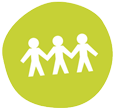Our services for education, care and protection are working together to ensure all children and young people are known, safe, well and learning.
We know schools play an important role in supporting the wellbeing of children and young people, and when students feel valued, safe and supported they are in their best position to learn.
As a department we:
- Have a common understanding of what ‘student wellbeing’ means.
- We value student voice. Schools listen to children and young people to plan action, and it guides Department planning and decision making.
- We support teachers to promote positive student wellbeing.
- We deliver programs across all Government schools to support the wellbeing of all students.
Wellbeing is influenced by what happens outside the school gates, and we can only succeed by working together with students, families and our wider school communities.
For more information email wellbeing.unit@decyp.tas.gov.au
The six wellbeing domains
Our Child and Student Wellbeing Strategy supports the Tasmanian Child and Youth Wellbeing Framework (PDF, 1.4MB).
It adopts the six wellbeing domains defined by the Australian Research Alliance for Children and Youth:
 Loved, Safe and Valued
Loved, Safe and Valued
Objective: Learners have positive relationships and connections with others, feel safe and are respected in their learning environments
Learners experience many challenges throughout their lives. They need the tools to help them feel safe in their world.
These challenges may include:
- being bullied by a peer
- being impacted by trauma
- lacking confidence
- family instability.
It is important for children and students to have positive and trusted relationships in their education setting. We have a shared responsibility to ensure that students receive this support.
Support for Students
- School Social Workers
- School Psychologists
- Inclusive Practice Team
- Interagency Support Team
- School Health Nurses
- School Wellbeing Officers and Chaplains
- School Support and Wellbeing Teams
Curriculum resources and professional learning
There are many curriculum programs and resources to help our students feel loved, safe and valued.
Respectful Relationships Education – Resources to teach students about respectful relationships.
Bullying Stops Here – this webpage provides resources for educators, students, parents and carers. Content includes: articles, videos, webinars, infographics, teacher tools, and student leadership resources.
Student Wellbeing Hub – this is an Australian Government website. The resources available are underpinned by the Australian Student Wellbeing Framework. They support the creation of learning communities that:
- promote student wellbeing
- encourage respectful relationships.
Office of the eSafety Commissioner – a portal for:
- school-based online safety resources
- reporting online abuse (image-based abuse, cyberbullying and offensive and illegal online content).
eSmart (Alannah and Madeline Foundation) – offers a range of educational tools for:
- principals (tackling bullying and cyberbullying)
- teachers (lesson plans and training)
- students (classroom activities and active learning)
- parents (how to see the signs and get help)
Be You – a national initiative supporting children’s and young people’s mental health. It provides educators with professional learning, resources, and strategies. Be You consultants are available to support implementation of Be You within education settings.
Working it Out – Tasmania’s gender, sexuality, and intersex status support service. It offers a range of services including:
- individual support
- support groups
- support in schools
- professional learning.
Stay ChatTY Schools Program – a Tasmanian mental health awareness and suicide prevention program. Year 9 to 12 students in eligible schools can access the program. It is free of charge to eligible Tasmanian Government schools.
 Material Basics
Material Basics
Objective: Learners have materials to access and fully participate in education, and the resources to function well and actively engage.
The Department for Education, Children and Young People has a role to play in ensuring that the basics are in place for learners to access and fully participate in education.
This includes providing resources for a child or student to function well and actively engage.
What material basics look like varies in different learning environments. It may include:
- breakfast clubs to set students up for a day’s learning
- tools for learning such as laptops and books
- a school uniform to connect students to their school community
- transport to get to and from school.
Support for students
- School Social Workers
- School Psychologists
- School Health Nurses
 Healthy
Healthy
Objective: Learners have their physical, developmental, psychosocial and mental health needs met, with resources provided to support their growth.
Physical and mental health are key elements of wellbeing.
Positive and strong mental wellbeing allows students to engage, participate and learn.
Supporting mental wellbeing extends from prevention and early intervention through to intensive intervention.
Support for Students
- School Health Nurses
- School Social Workers
- School Psychologists
 Learning
Learning
Objective: Learners are supported to be curious, creative and empowered life-long learners.
A positive culture that promotes learning has many benefits. Children and students are able to explore, experiment and engage in their learning.
Social and emotional wellbeing plays an important role in education. We know that effective social and emotional skills have a positive impact on learning and achievement.
Support for students
- School Social Workers
- School Psychologists
- Speech and Language Pathologists
- Inclusion and Diversity Services
- Inclusive Practice Team
- School Health Nurses
- Support for students who are caring for others
 Participating
Participating
Objective: Learners are able to have a voice with their views taken into account and are involved in decision-making that affects them and their learning
For positive wellbeing, learners must:
- be active participants in their own learning
- have opportunities to have their voice heard
- have opportunities to influence decisions about their learning.
Each student is entitled to a learning environment that:
- is safe
- is inclusive
- is responsive to their needs and aspirations
- allows them to participate and thrive.
Support for Students
- Support for students who are caring for others
- Inclusive Practice Team
- School Social Workers
- School Psychologists
- Speech and Language Pathologists
- Inclusion and Diversity Services
- School Health Nurses
 Positive Sense of Culture and Identity
Positive Sense of Culture and Identity
Objective: Learners have a positive sense of identity and belonging, and are optimistic about their future and success in learning.
For our learners to be well and succeed, they must:
- feel that they belong
- have a safe, valued and respected place in their learning environment.
Resilience, positive self-image and self-esteem are important life-long qualities for all learners.
Aboriginal Education Services
Aboriginal Education Services works with schools and the Department to:
- enable all Aboriginal and Torres Strait Islander young people to reach their learning potential
- help all learners understand and value Aboriginal and Torres Strait Islander histories and cultures
- build connections between our learning environments and the families of Aboriginal learners.
The Orb
The Orb is a publicly available website. It assists the teaching of Tasmanian Aboriginal Histories and cultures, and is suitable for all year groups.
English as an Additional Language
The English as an additional language (EAL) team works with schools to:
- strengthen teaching and learning practices for English language learners
- ensure all English language learners have the opportunities to engage in learning
- establish links between home and school for EAL students and families
- support the health and wellbeing of all EAL students by:
- fostering cultural responsiveness amongst staff, students and the school community.
LGBTIQ+ Students
Working it Out
Working it Out helps create safe and inclusive environments for LGBTIQ+ students, staff and families. Funded by the Department, Working it Out works with schools, teachers, and families.
Their Valuing Diversity Framework (PDF, 1350KB) works towards reducing stigma and creating inclusion.
